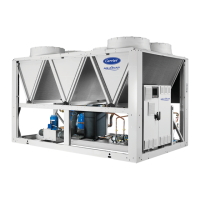
Do you have a question about the Carrier Aquasnap 30RB 060R and is the answer not in the manual?
Verify unit and accessories for damage or missing parts. Compare nameplate data with order.
Guidelines for safely moving the unit, recommending specialized personnel and proper lifting techniques.
Requirements for outdoor installation, ensuring stability, level surface, and adequate clearances for maintenance.
Table detailing physical specifications like sound levels, dimensions, weight, and component data.
Detailed electrical data including voltage, current, power, and start-up characteristics for unit models.
Information on the unit's ability to withstand short-circuit currents under different protection scenarios.
Detailed electrical data for compressors, including current and power factor values.
Requirements for the power supply, including voltage range and phase imbalance warnings.
Guidelines for selecting appropriate cable sizes based on installation conditions and regulations.
Continued guidelines for selecting appropriate cable sizes based on installation conditions and regulations.
Defines the operating limits for water and air temperatures for different unit configurations.
Essential precautions and recommendations for connecting water circuits and ensuring proper heat exchanger function.
Schematic diagrams of hydraulic circuits with and without hydraulic modules, detailing components.
Visuals of hydraulic modules for different unit sizes, showing dual pump and buffer tank configurations.
Control method using variable speed pumps to maintain constant pressure differential.
Control method using variable speed pumps to maintain a specific temperature difference.
Charts showing available static pressure for high-pressure pumps related to water flow rate.
Charts illustrating available static pressure for low-pressure pumps against water flow rate.
Comprehensive checklist of pre-start-up inspections for the unit and system, including visual and documentation checks.
Procedures for unit commissioning, emphasizing qualified supervision and pre-startup tests.
Key checks for compressors, hydraulics, and refrigerant charge before operating the unit.
A table listing various unit options, their descriptions, advantages, and applicable models.
Continuation of the options table, covering more features like communication gateways and corrosion protection.
Further options listed, including buffer tank modules and free cooling management.
Details on the brine option for low-temperature production, including frost protection and glycol concentration.
Checklist for verifying unit installation, power supply, wiring, and protection.
Checks for pump connection, oil level, leak checks, and voltage imbalance.
Procedure for measuring and plotting evaporator pressure drop to determine flow rate.
Steps for performing quick tests, configuring user menus, and starting the chiller.












